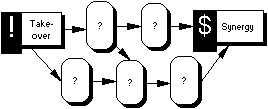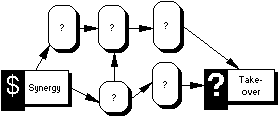
 |
making a mergerquick
march through the merger minefield
|
> King Solomon
|
Merger and acquisition activity is everywhere.
Banking, insurance, pharmaceuticals, oil, car manufacturers, telecommunications,
publishing, software ... can you name an industry that doesn't have any
major consolidation going on right now?
The stakes are high. A successful bid will have convinced a range of interested parties, possibly including shareholders and institutions, directors, managers and workers, governments, regulators and the media. Promises have been made, expectations have been set. Now it's time to deliver the goods. Mergers are complex and risky endeavours. Even wise King Solomon botched one. Veryard Projects applies clear, simple and yet innovative thinking to the management of complexity and risk. Our approach is based on the component-based business - a way of structuring an enterprise, process, organization or system in which self-contained units (or "components") provide services to one another. This provides a clear and simple
framework for understanding the full implications of the task facing the
merged organization, and for planning and managing the merger programme.
|
 |
King Solomon's Mergerveryard projects > cbb > mergers > King Solomon |
 |
Approach: Component-Based Businessveryard projects > cbb > mergers > approach |
This can be regarded as a form of component-based business. Instead of a single platform supporting a single business, the merged company operates a single platform that provides services to multiple businesses.
If the prior operating configurations of the merging companies were favourable, we might imagine that the post-merger integration could be effected extremely quickly and easily, simply by plugging them together as components of an enlarged structure. At present, this remains an unrealized dream for most large industries currently undergoing consolidation. However, component-based thinking is still valuable in managing the post-merger integration programme, and in preparing organizations and systems for potentially easier mergers in future.
Component-based thinking can be valuable when considering the final configuration of the enterprise. It is even more important when considering a step-by-step transition to this configuration from the given starting point of two separate operations. Dividing a merger programme into separate components typically makes it much easier to deliver results - provided of course that the components and steps are well chosen.
 |
Critical Success Factorsveryard projects > cbb > mergers > critical success factors |
| All significant risks identified, with clear ownership and strong management. | |
| Clear linkage and synchronization between system change and business change. | |
| Single managed programme for all ongoing development and migration projects. | |
| Common business model (architecture), against which all projects are positioned, scoped and controlled. | |
| Common managed knowledge base (repository) for detailed models and documentation. | |
| Balanced organization, with the best people from both sides working harmoniously together. |
 |
Pitfallsveryard projects > cbb > mergers > pitfalls |
| Unproductive conflicts. Cultural and personal clashes. | |
| Haste. Excessive uncertainty & anxiety. Everything stops until the new organization structure is announced and key management positions are resolved. | |
| Lack of commitment. Lack of clear ownership. Disconnect between strategy and tactics. | |
| Loss or erosion of key assets. Break-up of effective teams. Loss of morale. | |
| Inward focus - overlooking important external opportunities and threats - neglecting customers and strategic partners. | |
| Neglect strategic goals. Neglect customer satisfaction. | |
| Systems and technology merger disconnected from the business operational merger. |
 |
Planning - before and after the mergerveryard projects > cbb > mergers > planning & analysis |
| From Take-over to Synergy | From Synergy to Take-Over |
|
|
|
 |
 |
There is a strange paradox here. Both of the diagrams appear to make sense, but when we put them side-by-side, they appear to be quite contrary to one another. This is because the two diagrams (and the objects in them) have to be interpreted differently. After the take-over, we are talking about real activities; before the take-over, we are only talking about paper or hypothetical activities.
Analysing acquisition
| "Final cause" | added value of merged company |
| "Material cause" | synergetic resources (the loci of added value) |
| "Formal cause" | synergetic structures (the forms of synergy) |
| "Efficient cause" | synergetic activities (resulting in synergy) |
 |
Evaluating the mergerveryard projects > cbb > mergers > evaluation |
| Many mergers promise synergy and other benefits, but then undertake a 2-3 year integration programme before these benefits are forthcoming. To start with, management will typically claim that everything is on-track and on-target, and it will be difficult to disprove such claims. | |
| Meanwhile, many people will feel negative about the merger, and will be looking to find fault. This may include former employees, especially staff made redundant, or managers whose power and position has been reduced. It may also include retained employees, who mourn (or seek to retain) the old culture. Recently, in an extreme case of this phenomenon, the former owner of a software house attempted a shareholder coup, trying to vote down the board of directors of the company that had bought him out. | |
| Following a merger, there are often fierce battles for cultural and political supremacy between the managers and staff on both sides. Positions will have been seized, but may take a long time to consolidate. | |
| Cultures on both sides may take decades to disappear. It is said that cultural traces of BEA and BOAC could be detected in British Airways twenty years after the merger. |
Here's an incomplete evaluation checklist.
| Have the promised synergies been achieved? | |
| Have the promises or plans been quietly abandoned or revised since the merger? | |
| Have external relationships with other companies been disrupted or cancelled? | |
| Have internal power positions been consolidated? |
 |
Business merger roadmap - streamsveryard projects > cbb > mergers > business streams |
| Manage Overall Merger Programme | Overall Coordination
Corporate Affairs Risk Management |
|
| Coordinate Marketing | Customers & Channels
Products & Services |
|
| Coordinate Procurement | Suppliers & Contracts | |
| Coordinate Alliances | Partnerships & Joint Ventures | |
| Align Business Processes & Operations | Workflow & Procedures
Methods & Capabilities |
|
| Align Organizations & Culture | Departments & Teams
Career Paths & Opportunities Responsibilities & Rewards |
|
| Combine Knowledge & Information | Competitor and Market Intelligence
Best Practices |
|
| Combine Systems & Technology | Hardware & Software - Architectures & Inventory
Computer Systems & Data Stores Projects |
|
| Combine Facilities | Property & Infrastructure |
 |
Technology merger roadmap - streamsveryard projects > cbb > mergers > technology streams |
| Management | Define goals and priorities for combined IT
Set expectations with key stakeholders. Coordinate all aspects of migration. Manage migration risks. |
|
| Organization | Create merged management teams.
Announce staff retention and redeployment policies. Identify knowledge and skills required for merged organization. Merge key projects, and transfer key staff into appropriate positions. |
|
| Technology
& Services |
Rationalize procurement for products & services.
Define target technical platform. Confirm scaleability of platform. Set standards for development and migration projects. Acquire and install appropriate tools and infrastructure. |
|
| Project | Combine all development and migration projects for both organizations
under a single programme.
Create transition plans for releasing functionality during parallel operation. Create transition plans for migration and decommissioning. |
|
| Architecture | Combine architecture teams across both organizations.
Establish a single unified set of architectural models. Map development and migration projects against architecture |
|
| Business--IT
Alignment |
Understand business processes for each organization.
Establish business model for combined organization. Define business process transition. Synchronize business change and IT change. |
 |
How we can helpveryard projects > cbb > mergers > how we can help |
| Merger Readiness Planning | Restructuring your business processes, organization and technical services (including IT) so that new acquisitions can be accommodated more smoothly and cost-effectively. | |
| Merger Prospect Evaluation | Checking a specific opportunity for structural and operational compatibility, and producing an outline strategy for implementing the merger if it goes ahead.. | |
| Post-Merger Programme | Planning all the complex activities required after the acquisition has taken place, up to and including the delivery of the promised benefits to the various stakeholders. | |
| Data Migration | Bringing IT services onto a common platform. |
| top |  |
|
Copyright © 2000-2001 Veryard Projects Ltd http://www.veryard.com/business/mergers.htm |